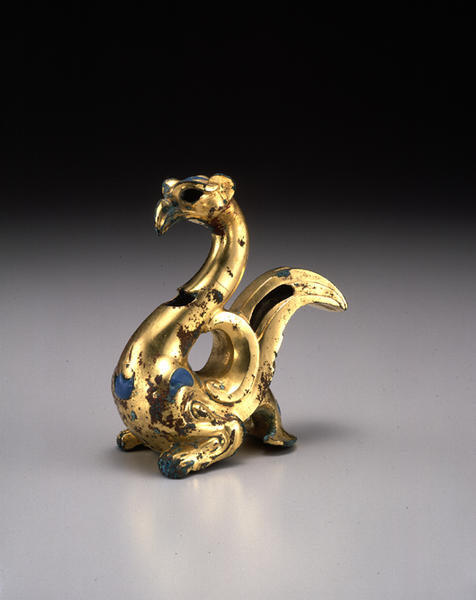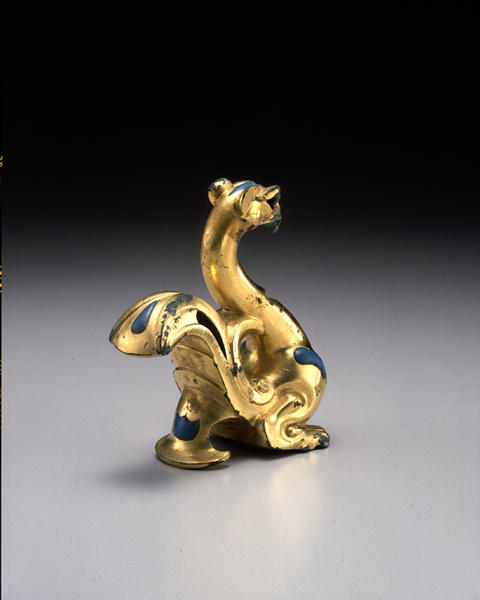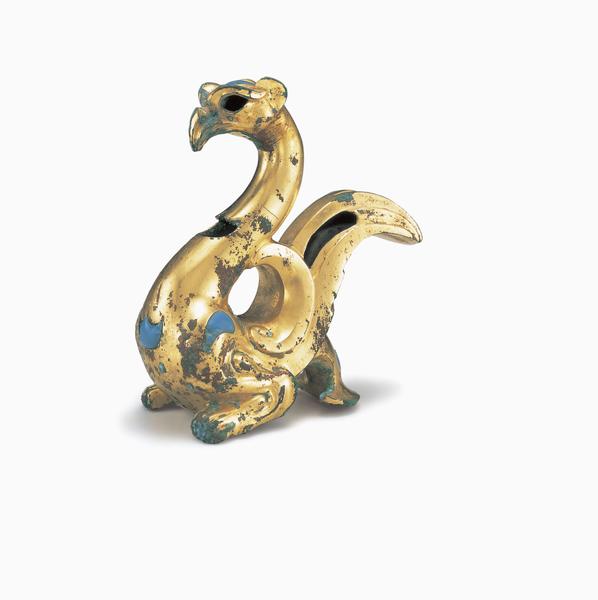Ornament in the Shape of Mythical Animal
- China
- China, Western Han period
- 3rd century B.C. - 1st century A.D.
- Gilded bronze, glass
- H-10.2 D-9 W-4.9
Catalogue Entry
This gilt bronze animal is created in an S-curved shape from the tip of the beak to the chest and body, through its head and neck. It also has a loop formed by the contour of its back and curling wings. The tail, extending from the abdomen, creates another S-curve. Its legs, extending from the front of the body back under the wings, suggest a strong, muscular beast's hind legs with sharp claws. At the root of the tail, a fan-shaped supporting leg is attached. Pieces of greenish blue glass are inlaid at the top of the head, chest, shoulders and fan-shaped leg. At the eyeholes, neck, and both sides of the tail, there are empty holes, probably once similarly inlaid.
This animal, reminiscent of ornaments in the shape of a phoenix on the lids of traditional Chinese bronze vessels, has the head of a phoenix, a beast's hind legs and symbolic small wings. Some elements are similar to features of the mythical griffin of the Eurasian steppes, which has the head of a vulture and the body of a beast. Foreign mythical creatures imported by way of the Northern Nomads during the Warring States period were adopted into literary Chinese traditions as auspicious signs. Chinese artisans, on the other hand, learned the foreign elements, which had been unknown till then, through manufacturing ornaments such as belt hooks for the northern tribes in the process of trading with them.
Contemporary examples similar to this piece can be seen in the Calon da Collection, a roundel including a vulture-headed creature with beast's body and forefeet with hoofs;*1 and also in the P. Uldry collection, a stylized vulture-shaped ornament with a beast's hind legs.*2 The line of the latter, from its head to the tail through the body, is similar to the line of this piece.
This piece was cast in the lost-wax method, and some rectangular chaplets are found at the left side of the neck, the right side of the face and the back of the tail. At the bottom of the body, there is a rectangular hole, which is thought to have served for attaching the piece to something else. On the bottom of the supporting foot, a Chinese character has been incised which can be read as 'gong' (fig. 1).
Catalogue Entry
This half-bird, half-animal shape resembles a phoenix at first glance and is a design frequently seen in northern China and among neighboring nomadic peoples. It is thought to have originated in depictions of griffins on the Eurasian Steppes. The body of the form is inlaid in seven places with blue glass thought to imitate turquoise stones, and this recalls the use of glass inlay to imitate turquoise seen in the decorative metel plaques made by the nomadic tribes of the Caucasus and Southern Siberia from this period. This is thought to have been created by a Chinese artisan who had been influenced by the northern nomadic cultures.


